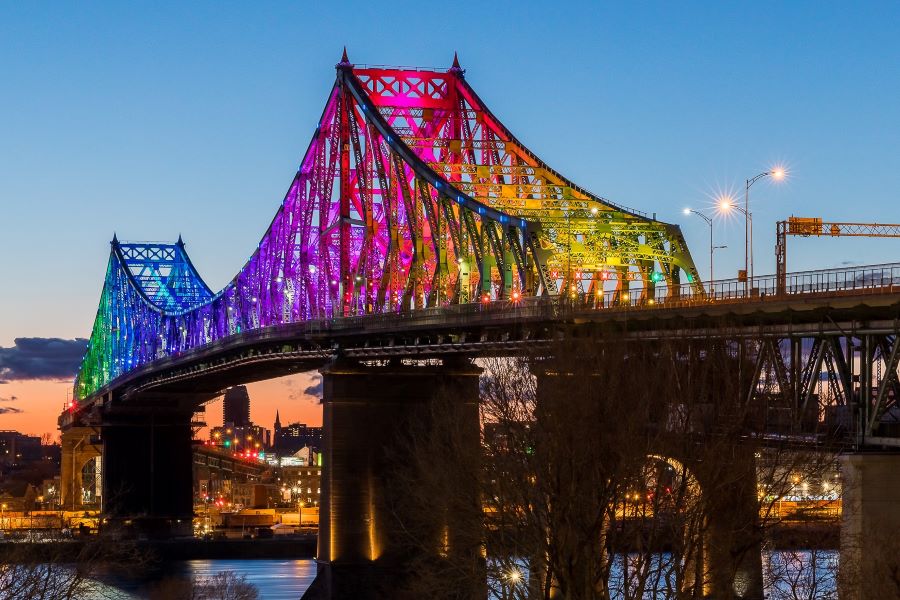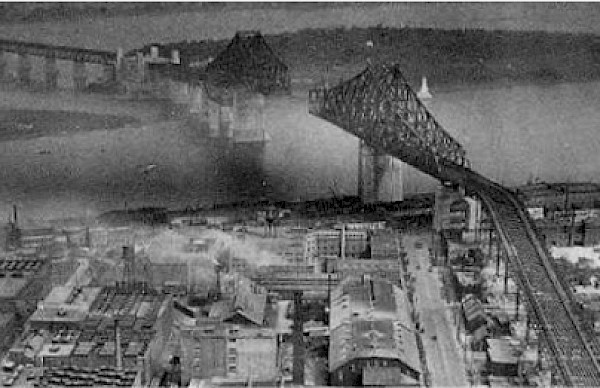About
Emblematic structure, the Jacques Cartier Bridge is an icon of Greater Montreal. Inaugurated in 1930, this five-lane bridge links Montreal to Longueuil and provides access to Île Sainte-Hélène.
In a nutshell
Opening of the Jacques Cartier Bridge: May 1930
Traffic
- Five traffic lanes
- Speed: 50 km/h
- Scooters: Authorized
- Cyclists (including bicycles and powered scooters): Authorized on the multipurpose path
- Pedestrians: Authorized on the multipurpose path and sidewalk
Weekdays, morning rush hour from 5:30 a.m. to 9:30 a.m.*:
- Three lanes open towards Montreal
- Two lanes open towards the South Shore
Weekdays, daytime from 9:30 a.m. to 3:30 p.m.:
- Two lanes open towards Montreal
- Two lanes open towards the South Shore
- Daytime, weekdays, maintenance works is frequently occur between 10 a.m. and 2 p.m. in the fifth lane
Weekdays, evening rush hour from 3 p.m. to 7:30 p.m.*:
- Three lanes open towards the South Shore
- Two lanes open towards Montreal
Weekdays, evening/night from 7:30 p.m. to 5:30 a.m.:
- Closure of the central lane from 7:30 p.m., after rush hour
- One lane opens in each direction from 1 a.m. to 4 a.m. when there is little traffic
- The Sûreté du Québec manages the operation of the central lane depending on the traffic situation
- Some lanes are closed late at night as a safety measure because there is no central median on Jacques Cartier Bridge
Weekends:
- Two lanes open in each direction (closure of the central lane)
- A third lane is open in either direction based on traffic needs
*These periods are subject to change according to the flow of traffic.
Vehicles less than 15 metres (less than 50 feet) in length:
- Authorized on the Jacques Cartier bridge
- Authorized on the access ramps leading to Parc Jean-Drapeau
Vehicles over 15 metres (over 50 feet) in length:
- Authorized on the Jacques Cartier Bridge,
- Prohibited on the access ramps leading to Parc Jean-Drapeau
Oversized trucks: license required
Towing: exclusive contract on the bridge
Monitoring: Sûreté du Québec
Technical data
- Total number of spans: 40 (24 on the Longueuil side and 16 on the Montreal side)
- Main channel width: 304.8 m between the wharf and the pier in the river
- Roadway width: 18.3 m between the curbs
- Multipurpose path width: 2.5 m
- Sidewalk width: 1.5 m
- Weight of steel of the bridge and pavilion (original construction): 33,267 tonnes
- Amount of concrete in the piers and other supports (original construction): 86,547 m3
- Amount of cut stone for the piers (original construction): 13,379.7 m3
- Amount of gravel and other fill materials in the embankments (original construction): 95,569 m3
- Amount of paint required for one coat (original construction): 38,641.8 L
- Number of piers: 28 piers, 2 abutments, 13 steel towers with 4 pedestals each and 60.9 m of concrete arches
- Number of rivets: Approximately 4 million
- Number of pneumatic caissons: 8
STRUCTURE
- Concrete for the deck and substructure of south approach and main span
- Steel for the superstructure and substructure of north approach
DECK
- The bridge deck is 23.1 m wide. It has a multipurpose cantilever path on the upstream side and a pedestrian cantilever sidewalk on the downstream side
- The deck is supported by riveted trusses that rest on concrete piers at the south approach and steel towers at the north approach
- In the cantilever section, dowels (trunnions) and tension anchors are used to articulate some of the assemblies
SOUTH APPROACHES
SECTION 1
Stops at the 326.2-m fill section at the south approach.
SECTION 2
Extends from Pier 1 to Pier 9.
SECTION 3
Spans the St. Lawrence Seaway and is approximately 36.6 m above the canal surface.
SECTION 4
Extends from Pier 10 to Pier 19A, which is the southern boundary of the Île Sainte-Hélène Pavilion.
SECTION 5
The Île Sainte-Hélène Pavilion is a three-story building. A rare example of Art Deco architecture in Montreal it is being renovated for a new use. It has a pedestrian tunnel decorated with murals that lets people get from one side of the bridge to the other under the traffic lanes.
SECTION 6
Extends from the north boundary of the Île Sainte-Hélène Pavilion to Pier 23.
MAIN SPAN
SECTION 7
The most recognizable part of the bridge, this cantilever section extends from Pier 23 to Pier 26 and spans the St. Lawrence River. It has two anchor spans at each end, two cantilever spans and a central suspended span. The bridge engineers combined aesthetics and technique to create a remarkable interplay of proportions.
The main span includes the four finials often called the “Eiffel Towers.” From the deck, you would never believe that each one is nearly 4.6 m tall and weighs about 6 tonnes!
NORTH APPROACHES
SECTION 8
Includes a section with steel towers.
SECTION 9
North approaches that are partly on concrete arches.
ILLUMINATION – LIVING CONNECTIONS
Thanks to intelligent programming, the Jacques Cartier Bridge is the first connected bridge that comes alive every night and changes with the rhythm of Montreal’s seasons and energy.
- 2,807 lights
- 10.4 km of cables
- 50,000 hours: estimated lifespan of the LED lights





